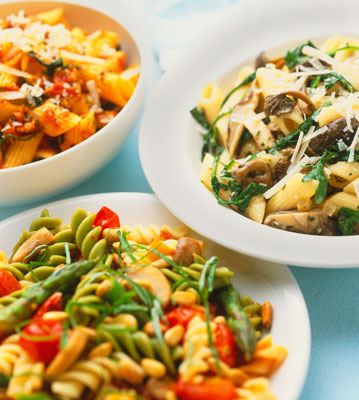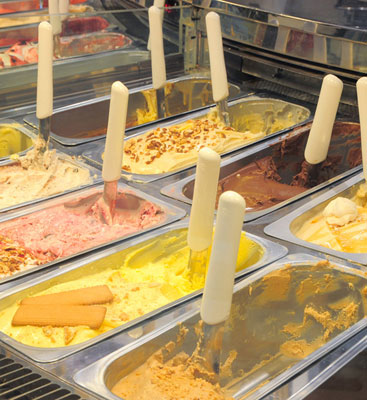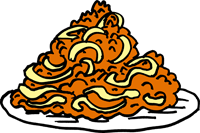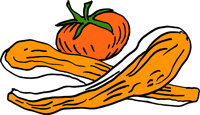< Introducing Rome
Where to Eat

A variety of pasta dishes
Going out to eat with children is very much the norm in Italy, and Rome is no exception. The culture of eating with the family is just as important as exposing children to good food. Most city restaurants welcome kids. It is accepted practice for toddlers to share their parents’ food and for older children to be given half portions. There are no kids’ menus. Prices given in this guide allow for a two-course lunch for a family of four (two adults and two children) without wine.
Practical information
Traditional Italian meals consist of an antipasto (starter), primo (pasta, risotto or soup), secondo (meat or fish), contorno (vegetable) and dolce (dessert) if you want something sweet to finish with.
Lunch is generally eaten between noon and 3pm. Restaurants are usually open for dinner between 7pm and midnight, but few Italians will eat before 8:30pm. Most eateries close one day a week, although in the centro storico many stay open seven days. In many restaurants a cover charge will be added to the bill and, in some, a service charge will be included too. Where it is not, it is common to leave a small tip, which is usually up to 10 per cent.
Set menus offer great value for families, and several are recom-mended in this book; some places have a series of formulas, allowing you to choose which and how many courses you want. Most menus will include water, and some will include wine, coffee and a cover charge – check carefully for hidden extras before ordering.
Types of restaurant
The once specific terms for different types of eateries have become blurred. A ristorante used to be a refined establishment of fine dining, but can equally apply to a joint round the back of Termini station dishing out indifferent pasta at inflated prices to unsuspecting tourists. Trattorie and osterie are pretty much inter-changeable, and can either be old-fashioned places serving simple food that haven’t changed in years, or terribly chic new establishments wanting to signal that they are re-visiting old culinary traditions. The original meaning of enoteca was simply “wine shop”. However, these days it is not restricted to shops that only sell wine, but also wine shops that serve a few snacks or meals, and fully-fledged restaurants that want people to know they have a serious wine cellar. Once upon a time pizzerias made only pizza, but these days they may well have pasta, meat and fish on the menu as well.
Cafés and bars
The average Italian visits simple café-bars at least twice a day – once for breakfast and again after lunch. These café-bars serve alcohol, soft drinks as well as coffee – most also sell pastries and sandwiches. In the
centro storico – especially around
Piazza Navona, the
Pantheon and
Piazza di Spagna – ordinary café-bars are almost impossible to find, but there is one on virtually every street corner elsewhere in the city. Most Italians eat or drink standing up at the bar – there is an extra charge for sitting at a table. Find a bar you like close to where you are staying and visit the place regularly to get a feel of your part of the city.
Breakfast
A typical bar breakfast comprises a cornetto (croissant) filled with crema (custard), cioccolato (chocolate custard) or Nutella, ricotta or marmellata (jam), washed down with a cup of coffee, hot milk or hot chocolate. Look out as well for fried, sugared, doughnut-like pastries and bignè (huge, puffy clouds of light pastry filled to bursting with custard or chocolate), most commonly available around the Festa di San Giuseppe (19 March).
Hot chocolate
The Italian version of hot chocolate is known as cioccolata calda. It is dense and intense – more like a pudding than a drink – and most easily eaten with a spoon – a method that may or may not be messier than drinking it. Some children adore it, others find the texture too thick, the flavour too strong, and the fact that it forms a crust as it cools positively disgusting. For such kids, order a latte caldo con cacao (hot milk with chocolate powder sprinkled on top and sugar on the side) – which is more like British and North American hot chocolate.
Picnics
Choosing to have picnic lunches in Rome will not only save money, but also give your family the chance to savour some of the best food the city has to offer. The quality of ham, salami and cheese, even in the more modest corner shops, is acceptable, while the produce on sale in the speciality food shops scales gastronomic heights at prices that are too good to be true. Markets have a selection of fruit, vegetables and salads, and many of the city’s bakeries make pizza, besides having a delicious range of breads.
Food to take away
Romans have been eating takeaway food for well over two millennia – ancient Roman apartment blocks did not have kitchens. Rome has numerous takeaway pizzerias that offer pizze al taglio (huge rectangular pizzas that are sold by the slice). Try to get them when they are fresh out of the oven. The best Roman pizza is light and crisp with a thin base.
Rosticcerie, which traditionally served spit-roast chicken, and the tavola calda (“hot table”) are direct descendants of the ancient Roman thermopolium (shops selling ready-to-eat food). Some dole out canteen-like food to tourists and workers, others offer delectable fare that should not be missed. Friggitorie devoted to making deep-fried street food such as dough balls; crumbed, deep-fried mozzarella or bechamel; baccalà (salt cod) and supplì (rice balls with a variety of fillings) are occasionally to be found, although such fried delicacies are often sold at cafés, tavole calde and pizzerias too.

Couple enjoying takeaway food
Catering for children and special diets
All but the very smartest restaurants will be happy to welcome children, even late into the evening. Kids are often fussed over and special requests, such as heating up baby food and asking for food to share, will usually be catered for. However, highchairs and changing facilities are uncommon outside tourist spots. Although welcome, children will be expected to sit at the table and not to run around, so it is best to warn them in advance.
Pasta al pomodoro (pasta with tomato sauce) is the fail-safe Italian alternative to a children’s menu, which rarely exists, but carbonara (bacon and egg), amatriciana (bacon and tomato) and pesto are just some of the other child-friendly sauces. Those with an aversion to tomato can choose rice or pasta in bianco (white), which comes plain with grated cheese, or pizza bianca.
Sandwiches and panini
Tramezzini (triangles of white bread with fillings) are rarely very tasty, but a simple tost (toasted white bread with ham and cheese) can be delicious. Many cafés have a good range of panini, in a variety of breads, that can be served as they are, or toasted on a grill. Good combi-nations are grilled aubergine and mozzarella, basil and tomato, and a chicken cotoletta (cutlet) with iceberg lettuce. A pizza bianca, split open and filled, is another tasty option.
Vegetarian
There are few strictly vegetarian restaurants, although Italian cuisine includes many meat-free dishes. The concept of vegetarian food is more widely understood now, although those of a nervous disposition may wish to check that there are no brodo di carne (broth), pancetta (bacon) or other meat products used in a dish before ordering. Vegan requirements may not be understood so be ready to explain carefully what you cannot eat – check using an online translator.
Ethnic food
Rome is far from being a multi-ethnic city by American or Northern European standards, although it is becoming increasingly diverse racially. Ethiopian, Eritrean, North African, Brazilian and Indian restaurants and shops cater to the city’s immigrant communities, while the presence of new Japanese and Southeast Asian restaurants reflects the contemporary trend.
Sweet treats and ice cream
Pasticcerie (pastry shops) are sometimes attached to cafés and they sell a mixture of cakes and biscuits. Bakeries (panetterie) are also a good source of ready-to-eat treats – many of them sell pizza and biscuits as well as freshly baked bread. There are gelaterie (ice-cream parlours) everywhere, but ice cream is not excellent universally and sometimes is artificially flavoured and coloured. Even ice cream which is advertised as produzione artigianale (hand-crafted) and produzione propria (home-made) can often be found to be simply ice cream made in a machine on the premises using factory-made pastes and powders.
However, there are a host of fabulous ice cream shops around town, from Giolitti, which started in 1900, to others such as San Crispino and Grom. These companies have revolutionized the world of ice cream. They only use natural and/or organic produce, which change according to the seasons.

Various flavours of organic gelati on display
The aperitivo
A fixed-price apéritif, served with abundant snacks – or with free access to a buffet – is becoming increasingly popular. It is often advertised as another Happy Hour option, and can be an excellent way to relax in the early evening, when children are peckish and parents too are in need of a drink. Some of the more chic bars are adults only.
The most family-friendly places are those opening onto a pedestrianized piazza, so that children can run around and play while parents unwind.
Coffee world
Caffè
A short, strong shot of coffee, which is popularly known as an espresso abroad
Caffè lungo
Slightly longer and weaker than regular caffè – the water is allowed to run through the coffee for a bit longer
Cappuccino
Shot of coffee with hot and frothy milk
Caffè freddo
Cold, sweet coffee
Caffè macchiato
Caffè with a dash of hot milk
Caffè Americano
Caffè with hot water added to approximate American filter coffee
Latte macchiato
Hot milk with a dash of coffee
Caffè latte
Can either be like a cappuccino without foam or a stronger version of a latte macchiato
Caffè corretto
Caffè with a shot of alcohol – grappa, sambuca and amaretto are common additions
Caffè con panna
Caffè with whipped cream
Kids’ Corner
Offally rich
Dominated by offal, cucina romana is not for the faint-hearted, nor for those watching their waistline or cholesterol levels. Its origins are with the city’s poor, who could only afford the bits of meat richer folk did not want. Liver on toast and braised oxtail with celery are some such dishes.
Offal-free Roman specialities
For those who cannot stomach offal, there are still several pretty much ubiquitous
cucina romana dishes that are likely to appeal:
spaghetti cacio e pepe – with grated pecorino cheese and freshly ground black pepper
bucatini all’amatriciana – hollow spaghetti-like pasta with a sauce of bacon and tomato
scottadito – tiny lamb chops eaten with the fingers
Tasty phone cables!!
The best kind of supplì is the supplì al telefono – a crumbed, deep-fried ball of risotto that turns into a telephone! When you bite into the ball of melted mozzarella in the middle you can stretch it out with your teeth like an old-fashioned phone cable.
American spaghetti
According to legend, spaghetti alla carbonara was invented by American soldiers in Italy during World War II, who added their rations of bacon and dried egg to the local pasta. It has now become a Roman staple, but raw egg yolk replaces the egg powder.
How to buy an ice cream in Italy
Find a shop with a queue of Italians outside (locals will know the best place), ideally advertising
gelato artigianale (home-made ice cream). Then choose between a cone (
cono) or cup (
coppetta) and select from the colourful array of flavours. You can ask for a taste and to combine two flavours. In some places you may be offered cream to top it off. Child-sized cones are often available too. Here are some of the flavours you’ll find:
Amarena cream with cherries
Bacio chocolate and hazelnuts
Cioccolato al latte milk chocolate
Cioccolato all’arancia chocolate with orange
Cioccolato con peperoncini chocolate with spicy chilli
Cioccolato fondente dark chocolate
Fior di latte sweet cream
Frutti di bosco fruits of the forest
Rome’s famous gelaterie
Al Settimo Gelo (Via Vodice 21)
Alberto Pica (Via della Seggiola 12)
Fata Morgana (Via degli Zingari 5)
Fior di Luna (Via della Lungaretta 96)
Gelarmony (Via Marcantonio Colonna 34)
Giolitti (Via Uffici del Vicario 40)
Grom (Via della Maddalena 30 a)
Mela e Cannella (Via Oderisi da Gubbio 71)
San Crispino (Via della Panetteria 42)







